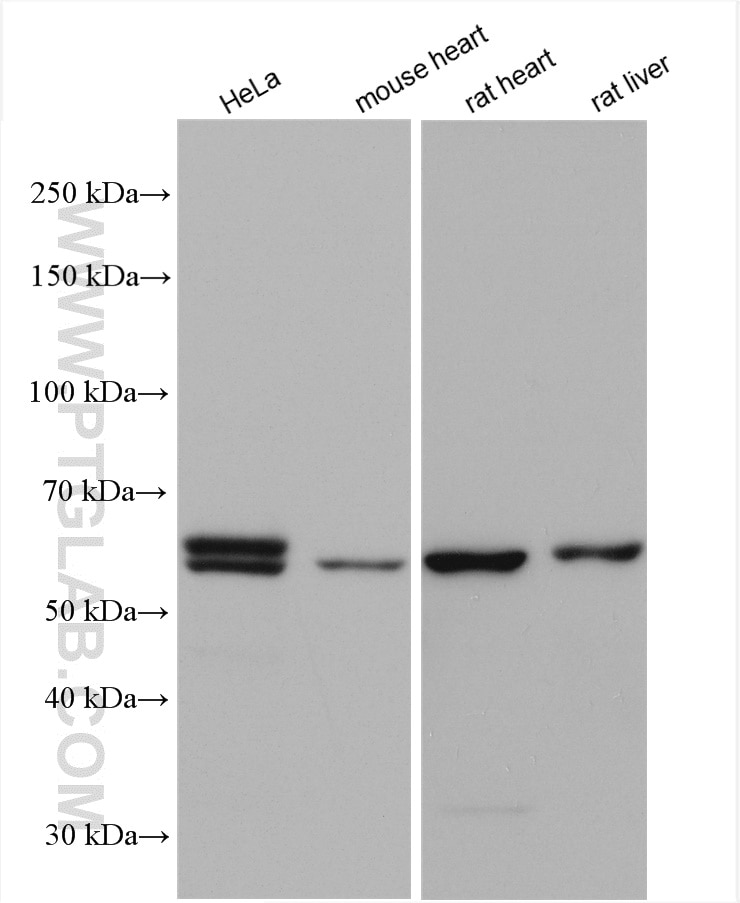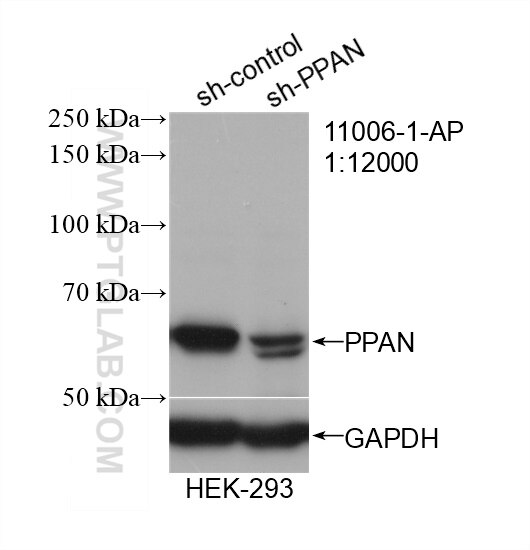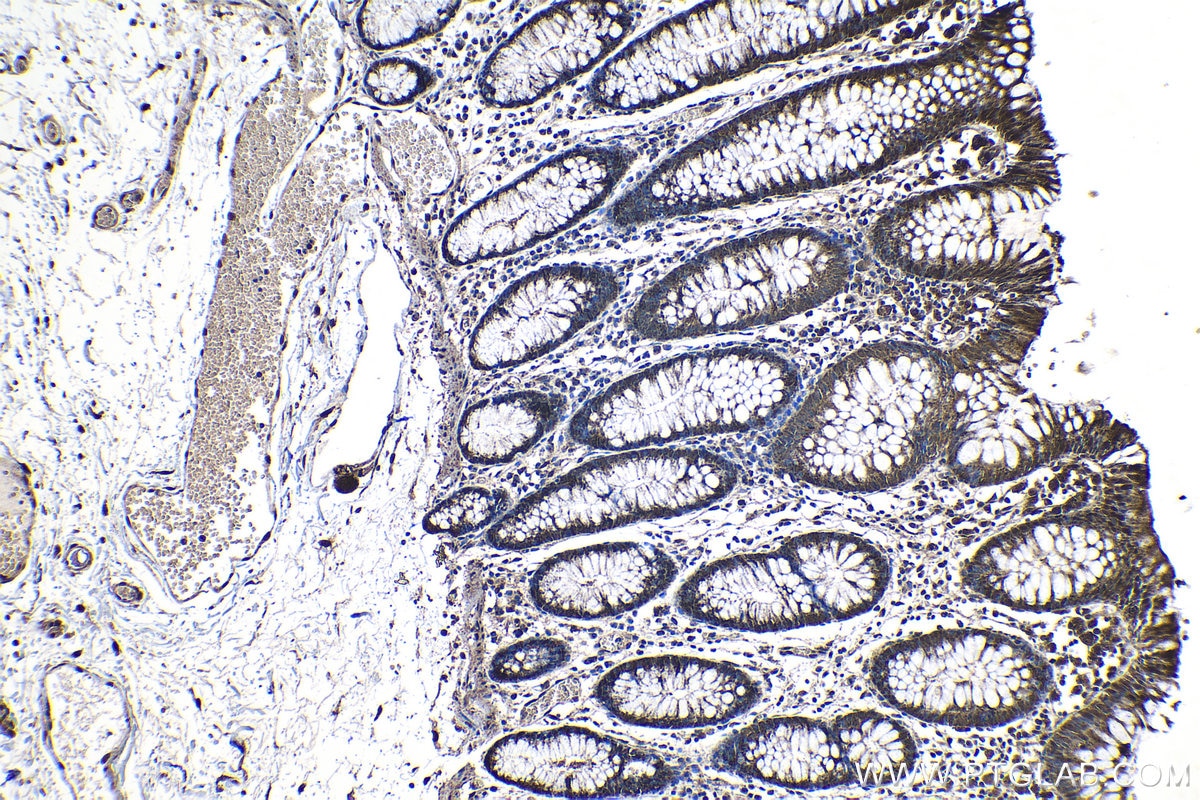- Phare
- Validé par KD/KO
Anticorps Polyclonal de lapin anti-PPAN
PPAN Polyclonal Antibody for WB, IHC, ELISA
Hôte / Isotype
Lapin / IgG
Réactivité testée
Humain, rat, souris et plus (1)
Applications
WB, IP, IF, IHC, ELISA
Conjugaison
Non conjugué
N° de cat : 11006-1-AP
Synonymes
Galerie de données de validation
Applications testées
| Résultats positifs en WB | cellules HeLa, tissu cardiaque de rat, tissu cardiaque de souris, tissu hépatique de rat |
| Résultats positifs en IHC | tissu de côlon humain, il est suggéré de démasquer l'antigène avec un tampon de TE buffer pH 9.0; (*) À défaut, 'le démasquage de l'antigène peut être 'effectué avec un tampon citrate pH 6,0. |
Dilution recommandée
| Application | Dilution |
|---|---|
| Western Blot (WB) | WB : 1:1000-1:4000 |
| Immunohistochimie (IHC) | IHC : 1:500-1:2000 |
| It is recommended that this reagent should be titrated in each testing system to obtain optimal results. | |
| Sample-dependent, check data in validation data gallery | |
Applications publiées
| KD/KO | See 4 publications below |
| WB | See 6 publications below |
| IHC | See 1 publications below |
| IF | See 2 publications below |
| IP | See 2 publications below |
Informations sur le produit
11006-1-AP cible PPAN dans les applications de WB, IP, IF, IHC, ELISA et montre une réactivité avec des échantillons Humain, rat, souris
| Réactivité | Humain, rat, souris |
| Réactivité citée | Humain, souris, xénope |
| Hôte / Isotype | Lapin / IgG |
| Clonalité | Polyclonal |
| Type | Anticorps |
| Immunogène | PPAN Protéine recombinante Ag1419 |
| Nom complet | peter pan homolog (Drosophila) |
| Masse moléculaire calculée | 53 kDa |
| Poids moléculaire observé | 55-58 kDa |
| Numéro d’acquisition GenBank | BC009833 |
| Symbole du gène | PPAN |
| Identification du gène (NCBI) | 56342 |
| Conjugaison | Non conjugué |
| Forme | Liquide |
| Méthode de purification | Purification par affinité contre l'antigène |
| Tampon de stockage | PBS avec azoture de sodium à 0,02 % et glycérol à 50 % pH 7,3 |
| Conditions de stockage | Stocker à -20°C. Stable pendant un an après l'expédition. L'aliquotage n'est pas nécessaire pour le stockage à -20oC Les 20ul contiennent 0,1% de BSA. |
Informations générales
PPAN (or SSF, SSF1 or SSF2) gene is widely expressed, and encodes peter pan homolog protein which may be localized in nucleus. Two isoforms are produced through alternative splicing. So far the characterization of this protein is largely unknown, multiple phosphorylation sites has been revealed based on high-throughput phosphorylation analysis. This antibody is raised against the C-terminal of huaman PPAN and recognize bands around 55 kDa.
Protocole
| Product Specific Protocols | |
|---|---|
| WB protocol for PPAN antibody 11006-1-AP | Download protocol |
| IHC protocol for PPAN antibody 11006-1-AP | Download protocol |
| Standard Protocols | |
|---|---|
| Click here to view our Standard Protocols |
Publications
| Species | Application | Title |
|---|---|---|
EMBO J The long non-coding RNA Paupar promotes KAP1-dependent chromatin changes and regulates olfactory bulb neurogenesis. | ||
Development Peter Pan functions independently of its role in ribosome biogenesis during early eye and craniofacial cartilage development in Xenopus laevis. | ||
Cancers (Basel) Nucleolar Stress Functions Upstream to Stimulate Expression of Autophagy Regulators.
| ||
J Biol Chem The Wnt target Peter Pan defines a novel p53-independent nucleolar stress response pathway.
| ||
Biol Cell Pescadillo homologue 1 and Peter Pan function during Xenopus laevis pronephros development. | ||
Cells Loss of Peter Pan (PPAN) Affects Mitochondrial Homeostasis and Autophagic Flux.
|




